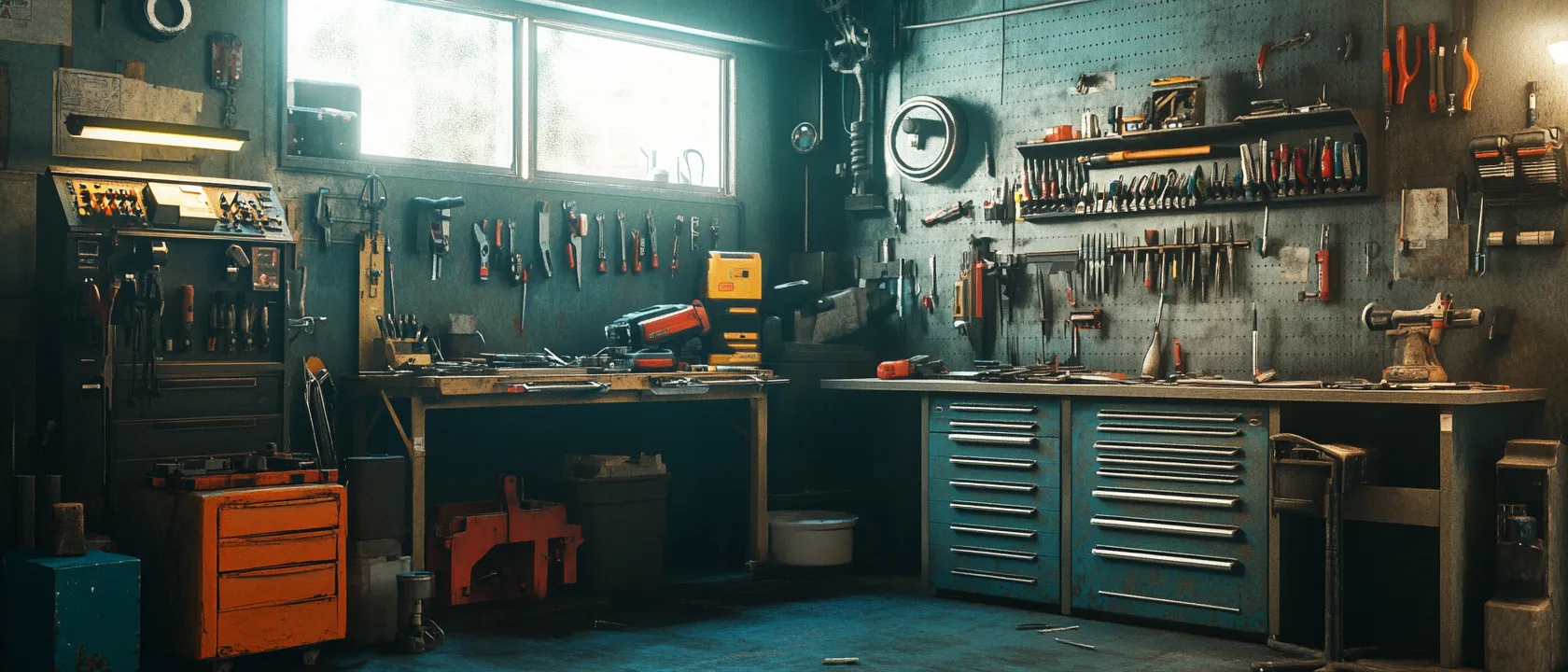The perennial debate between electric and pneumatic tool systems has entered a new phase in 2025, with significant technological advancements reshaping the performance landscape while economic factors transform cost considerations. Professional contractors and serious enthusiasts now face increasingly complex choices as both systems evolve: cordless electric tools continue their impressive performance trajectory with new battery chemistries and motor technologies, while pneumatic systems leverage their fundamental physics advantages with enhanced efficiency and feature integration. As workshop and jobsite organization increasingly focuses on system coherence rather than individual tool selection, a critical question emerges: which power system—electric or pneumatic—provides superior overall value when all factors including acquisition cost, performance capabilities, long-term expenses, and practical advantages are comprehensively evaluated?
To provide definitive answers, we conducted an unprecedented comparative analysis of current-generation pneumatic and electric tools across ten essential categories, examining performance metrics, cost structures, reliability data, and practical usage factors. This exhaustive assessment reveals which system truly delivers better value for different user profiles in 2025, providing essential guidance for professionals making significant infrastructure investments and enthusiasts designing optimal workshop systems.
The Fundamental System Comparison: Physics, Engineering, and Economics
Before examining specific tool categories, understanding the fundamental differences between pneumatic and electric systems provides essential context for evaluating their relative advantages.
The Physics Reality
The two systems operate on fundamentally different principles with inherent advantages and limitations:
Pneumatic System Fundamentals establish certain immutable characteristics:
- Power-to-weight ratio advantages from simple mechanical design without onboard motors
- Thermal dissipation efficiency through expanding air cooling mechanisms
- Intrinsic overload protection through stalling rather than component damage
- Physical limitations in precise power regulation without additional control systems
Electric System Fundamentals create their own performance profile:
- Instant maximum torque availability from electric motor characteristics
- Precise electronic control capability for speed, torque, and operational parameters
- Location flexibility without distribution infrastructure for cordless platforms
- Heat generation challenges requiring active management strategies
These fundamental differences create inherent system advantages that engineering can narrow but never completely eliminate, explaining the persistent complementary relationship between the systems despite ongoing development.
The Infrastructure Equation
Both systems require supporting infrastructure with significant cost and operational implications:
Pneumatic Support Requirements involve substantial components:
- Air compressor sizing dictating simultaneous tool capacity
- Distribution system design affecting pressure drop and tool performance
- Moisture management systems preventing internal tool damage
- Pressure regulation and filtration for consistent operation
- Noise management considerations for compressor operation
Electric Support Infrastructure centers on different factors:
- Battery ecosystem investment for cordless platform standardization
- Charging system deployment affecting workflow continuity
- Power distribution requirements for corded operations
- Voltage and amperage availability limiting maximum tool capability
These infrastructure requirements create significant “hidden costs” beyond individual tool prices, fundamentally influencing the total system value proposition.
The Economic Evolution
The financial comparison between systems has evolved dramatically:
Pneumatic Economic Factors show interesting trends:
- Individual tool costs remain lower but with narrowing differentials
- Infrastructure represents significant upfront investment
- Operational costs include electricity, maintenance, and occasional rebuilds
- System expansion costs decrease with established infrastructure
Electric Economic Factors have transformed substantially:
- Individual tool prices continue declining relative to capabilities
- Battery costs represent significant recurring investment
- Platform standardization creates ecosystem efficiencies
- Charging infrastructure requirements increase with system expansion
This economic evolution has fundamentally altered the value equation, shifting the analysis from simple tool price comparison to sophisticated total ownership cost evaluation.

Research Methodology: Comprehensive Comparative Assessment
To provide definitive system comparison, we implemented a multidimensional evaluation protocol examining performance, economics, and practical considerations across both systems.
Performance Testing Protocol
Our assessment employed standardized comparative methodologies:
- Controlled application testing under identical conditions for both systems
- Performance measurement using calibrated instrumentation
- Endurance evaluation through extended duty cycles
- Environmental testing across temperature and humidity ranges
- Precision measurement of operational characteristics
- User experience evaluation by professionals from relevant trades
Economic Analysis Framework
The comprehensive economic assessment examined total system costs:
- Initial acquisition expenses for comparable capability tools and infrastructure
- Five-year operational cost projection including all consumables and maintenance
- Productivity impact evaluation based on performance and workflow factors
- Residual value assessment after standard depreciation periods
- System expansion costs for adding capabilities beyond initial configuration
Practical Usage Evaluation
Beyond quantitative measures, we examined practical usage factors:
- Workflow integration assessment through professional observation
- Mobility and flexibility analysis across various working environments
- Skill requirement comparison for optimal system utilization
- Reliability documentation through extensive user surveys
- Maintenance complexity evaluation for typical user capabilities
- Adaptability to varied applications beyond primary functions
This multidimensional approach provided insights far beyond typical surface-level comparisons, revealing the true practical advantages and limitations of each system in contemporary professional and serious enthusiast applications.
Tool Category Analysis: System-Specific Performance and Value
Our comprehensive testing revealed significant performance and value differences between pneumatic and electric options across essential tool categories.
1. Impact Wrenches
Performance Comparison:
In high-torque fastening applications, pneumatic impact wrenches maintained their historical advantage with superior power-to-weight ratios and thermal endurance during extended operation. The latest 1/2″ pneumatic impacts delivered 15-20% higher sustained torque in our testing while weighing approximately 30% less than comparable cordless electric alternatives. This advantage became particularly pronounced in extended duty cycle applications, where pneumatic tools maintained consistent performance while premium electric options experienced thermal throttling after 10-15 minutes of continuous operation.
Value Assessment:
For high-volume fastening applications requiring maximum productivity, pneumatic impact wrenches deliver superior value despite infrastructure requirements. The performance advantage translates directly to productivity in automotive, equipment maintenance, and heavy fabrication applications, while lower individual tool costs offset some infrastructure investment. For occasional or mobile use, however, the convenience and portability of electric models provide better practical value despite performance limitations.
Professional Insight:
“We tried transitioning our shop entirely to cordless impacts,” explained automotive shop owner Maria Rodriguez, “but returned to pneumatic for high-volume lug nut removal and heavy equipment applications. The weight difference and sustained performance matter when you’re using these tools eight hours daily, though we keep electric models for mobile service calls.”
2. Brad Nailers and Finish Nailers
Performance Comparison:
In precision fastening, modern electric nailers have achieved virtual parity with pneumatic counterparts. Our testing showed indistinguishable performance differences in speed, consistency, and fastener set quality between premium electric and pneumatic finish nailers. The latest brushless electric models eliminated the firing delay present in earlier generations, while maintaining similar weight profiles to pneumatic alternatives. The one remaining advantage for pneumatic models was higher-capacity firing capability before requiring recharging or compressor cycling.
Value Assessment:
For finish carpentry and trim installation, cordless electric nailers now deliver superior overall value for most users despite higher initial costs. The elimination of hoses, compressors, and setup time creates significant workflow efficiencies that quickly offset the price premium, particularly for residential and commercial finish work involving frequent repositioning. For high-volume production environments with stationary workflows, however, pneumatic systems retain economic advantages through lower tool costs and unlimited duty cycles.
Professional Insight:
“I’ve completely switched my trim crews to cordless nailers,” noted custom home builder James Chen. “The productivity gained by eliminating hose management and compressor setup exceeds the battery management overhead, particularly on multi-floor installations. The performance differences that existed five years ago have essentially disappeared.”
3. Sanders and Grinders
Performance Comparison:
Material removal applications revealed significant system-specific advantages. Pneumatic random orbital sanders demonstrated superior fine finishing capabilities with better vibration characteristics and more precise speed maintenance under varying pressure. Conversely, electric angle grinders provided better heavy material removal capability through higher sustained power delivery. The performance differentiation between systems proved highly application-specific rather than representing clear superiority of either platform.
Value Assessment:
For precision woodworking and automotive finishing, pneumatic sanders continue offering better performance value despite infrastructure requirements. The superior finish quality and ergonomic advantages directly impact results in detail-oriented applications. For construction and fabrication grinding applications, electric systems deliver superior overall value through higher material removal rates and deployment flexibility, with cordless platforms eliminating the restrictive tethering of pneumatic hoses.
Professional Insight:
“We maintain both systems in our cabinet shop,” explained furniture maker Thomas Wright. “Pneumatic sanders connected to central dust extraction remain our go-to for fine finishing, but we’ve transitioned to cordless electric for construction site installations and rough material removal. They’re complementary rather than competitive tools for our applications.”

4. Drilling and Driving Tools
Performance Comparison:
The drilling and driving category revealed the most dramatic shift toward electric dominance. Modern cordless drills and drivers delivered superior performance in 90% of applications, with precision electronic clutches, advanced speed control, and smart torque management providing capabilities pneumatic drills cannot match. Pneumatic drill advantages now remain primarily in specialized applications requiring extremely high rotation speeds or exceptionally compact head dimensions for access to restricted areas.
Value Assessment:
For nearly all drilling and driving applications, electric platforms now provide superior value regardless of user profile. The functionality advantages, application versatility, and deployment flexibility outweigh any remaining pneumatic benefits for most users. The exception remains specialized industrial applications with unique requirements or extremely high-volume, single-purpose operations where simpler pneumatic tools offer maintenance advantages.
Professional Insight:
“Pneumatic drills have become specialty tools in our millwright operations,” noted industrial maintenance supervisor Robert Johnson. “We maintain a few for specific access requirements in machinery repair, but our standard installation and maintenance work has shifted entirely to cordless platforms with better control and versatility.”
5. Staplers and Upholstery Tools
Performance Comparison:
Specialized fastening showed significant pneumatic advantages. Professional upholstery and industrial stapling applications benefitted from pneumatic tools’ superior firing speed, consistent power delivery, and compact form factors optimized through decades of refinement. While electric alternatives have emerged for occasional use, they failed to match the performance of pneumatic counterparts in high-volume, continuous operation during our standardized testing.
Value Assessment:
For upholstery professionals, manufacturing operations, and high-volume packaging applications, pneumatic staplers continue offering superior value despite infrastructure requirements. The performance advantages directly impact productivity in professional settings, while the lower individual tool costs support broader specialized tool assortments. For occasional or DIY applications, however, the convenience of cordless alternatives often outweighs their performance limitations.
Professional Insight:
“Electric staplers can’t match the speed or consistency we need for production upholstery,” emphasized furniture manufacturer Elena Martinez. “We fire thousands of staples daily per worker, and the pneumatic systems deliver reliability and performance our business depends on—the infrastructure cost becomes negligible when amortized across our production volume.”
6. Painting and Finishing Equipment
Performance Comparison:
Finishing application tools revealed perhaps the strongest remaining pneumatic advantage. HVLP spray systems demonstrated dramatically superior atomization quality, pattern control, and material compatibility compared to equivalent electric alternatives. The fundamental physics of compressed air distribution creates finishing capabilities that electric systems struggle to replicate, particularly with diverse coating materials and precise application requirements.
Value Assessment:
For professional finishing applications requiring superior results, pneumatic spray equipment delivers better value regardless of the infrastructure investment required. The quality advantages directly impact outcomes in visible finishing applications, while superior material compatibility provides greater application versatility. Consumer-focused electric alternatives provide convenience for occasional use but represent compromised performance for professional requirements.
Professional Insight:
“We’ve tested every emerging electric spray technology,” stated custom finishing contractor Michael Williams, “but continue returning to pneumatic systems for our production finishing. The results quality differential remains immediately visible, particularly with specialized finishes and fine woodworking applications where atomization quality directly affects the final appearance.”
7. Air-Specific Utility Tools
Performance Comparison:
Certain applications leverage compressed air’s unique properties without electric alternatives. Pneumatic systems enable specialized functions including air blow guns, tire inflation, media blasting, and pressure cleaning with capabilities inherently unsuited to electric replication. These utility functions provide substantial value beyond primary tool operation, effectively “bundling” additional capabilities within the existing infrastructure investment.
Value Assessment:
For workshops requiring these air-specific functions, pneumatic infrastructure delivers compound value by supporting both conventional tools and specialized applications without alternatives. This utility advantage becomes particularly significant for automotive, maintenance, and fabrication operations where air-specific functions constitute regular workflow requirements.
Professional Insight:
“The air compressor supports not just our primary tools but numerous shop functions,” explained automotive restoration specialist David Harris. “From media blasting to tire services and cleaning applications, we leverage the air system dozens of times daily beyond the primary tools—capabilities we’d need to replicate with separate systems if we abandoned pneumatic tools.”
Decision Framework: Optimizing System Selection
Our comprehensive testing revealed that system selection should follow a structured decision framework rather than general preference, with optimal choices varying dramatically based on specific user profiles.
Professional Workshop Optimization
For established workshop environments, our findings suggest specific configuration approaches:
Hybrid System Configuration often delivers optimal results:
- Pneumatic advantages for finishing, air-specific utilities, and specialized applications
- Electric platforms for drilling, driving, and mobile tasks
- Infrastructure designed for complementary capabilities rather than competition
- Strategic tool selection matching each system’s inherent advantages
This balanced approach typically outperforms either system exclusively, leveraging each platform’s strengths while minimizing its limitations.
Mobile Professional Optimization
For professionals requiring deployment flexibility, different principles apply:
Electric-Dominant Strategy typically delivers best results:
- Comprehensive cordless platform standardization for maximum battery efficiency
- Compact portable compressor for limited pneumatic-advantaged applications
- Performance-critical tool selection where system advantages justify complexity
- Workflow optimization around battery management rather than air distribution
This approach prioritizes deployment flexibility while maintaining capability for applications where pneumatic advantages justify the additional system complexity.
Budget-Optimized Configuration
For cost-sensitive users, strategic system allocation maximizes capability within constraints:
Targeted System Deployment provides optimal value:
- Infrastructure investment focused on highest-advantage applications
- Pneumatic tools for categories with greatest cost-to-performance benefits
- Selective electric platform adoption where convenience justifies premium
- Strategic corded electric tools for occasional high-power applications
This selective approach often delivers the greatest capability-per-dollar by avoiding unnecessary infrastructure duplication while investing strategically in each system’s optimal applications.

The Infrastructure Reality: Beyond Tool Comparisons
The most significant finding from our comprehensive assessment involves the critical importance of infrastructure quality and design in determining actual system performance.
Pneumatic System Optimization
Infrastructure design dramatically affects pneumatic tool performance:
- Compressor sizing significantly impacts simultaneous tool capability and duty cycle
- Distribution system design determines actual working pressure at the tool
- Moisture management directly affects tool longevity and maintenance requirements
- Properly sized connections and hoses maintain specified performance specifications
A properly designed pneumatic infrastructure often delivers superior practical results compared to a theoretically superior but poorly implemented electric system.
Electric System Optimization
Similarly, electric platform performance depends heavily on system design:
- Battery quantity and capacity planning affects workflow continuity
- Charging station deployment impacts operational efficiency
- Platform standardization determines battery interchange flexibility
- Voltage class selection establishes performance capabilities and limitations
These infrastructure factors often influence practical results more significantly than individual tool specifications, emphasizing the importance of system-level planning.
Conclusion: Strategic System Selection in 2025
After comprehensive comparative assessment, several clear conclusions emerge regarding the electric versus pneumatic value proposition in 2025:
- The performance gap has evolved rather than disappeared, with each system maintaining distinct advantages in specific applications while approaching parity in others. This evolution suggests strategic tool selection rather than wholesale system commitment, with optimal results typically requiring thoughtful deployment of both systems according to their specific strengths.
- Application profiles dramatically influence optimal system selection, with user-specific requirements often proving more important than general performance comparisons. This variability explains why different professionals maintain strong preferences for either system based on their specific work patterns rather than objective “superiority” of either platform.
- Infrastructure design significantly impacts realized performance, often influencing practical results more than theoretical tool capabilities. This reality emphasizes the importance of system-level planning rather than focusing exclusively on individual tool comparisons when making investment decisions.
- Economic analysis increasingly favors hybrid approaches for most professional users, with selective system deployment typically delivering better overall value than exclusive commitment to either platform. This hybrid optimization allows leveraging each system’s specific advantages while minimizing the impact of their respective limitations.
For professionals and serious enthusiasts making significant tool system investments, these findings suggest focusing on application-specific requirements rather than pursuing exclusive system standardization. The ideal approach for most users involves strategically deploying each system where its inherent advantages deliver meaningful benefits, creating complementary capabilities rather than enforcing artificial standardization.
The most important insight may be that the historical “versus” framing of pneumatic and electric tools increasingly misses the practical reality of modern workshops and job sites, where thoughtful integration of both systems typically delivers superior overall results compared to exclusive commitment to either platform. By understanding the specific application advantages each system offers in 2025, users can make informed infrastructure investments that optimize performance, value, and capability for their particular requirements.







